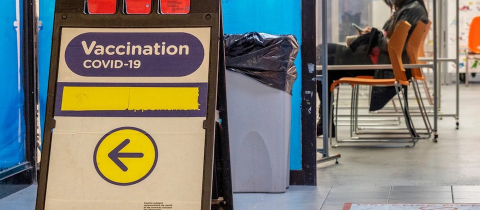No, we will not become genetic mutants when we finally get to roll up our sleeves and agree to be jabbed with a vaccine containing modified messenger RNA (mod-mRNA). That scare is making the rounds as the vaccine rollout begins, a culmination of a spectacular nine-month research effort. The term “modified” triggers alarm bells for some people, especially those who have bought into the often-misleading information about genetically modified organisms (GMOs) spread by activist groups. Fearful that their genes may somehow be modified by the vaccine, they conjure up memories of the fate that befell the Teenage Mutant Ninja Turtles. I think we can dismiss that fear, but as with any novel pharmaceutical intervention, there are legitimate concerns. First, some background.
Just about everything that happens in our body relies on the family of molecules we call proteins. Indeed, the term “protein” derives from the Greek for “in first place.” Proteins are polymers, long chain-like molecules with the component links being amino acids. Since the chains can be of various lengths with all sorts of twists and turns, and feature twenty amino acids that can be incorporated in diverse sequences, the number of possible protein structures is immense. Some proteins are the building blocks of muscles, some make up our hair and skin, some play key roles in immune function, some are hormones and others act as enzymes, the biochemical catalysts that control the myriad chemical reactions that go on in our body all the time and together constitute life. The instructions for making all these proteins are encoded in molecules of deoxyribonucleic acid (DNA) found in the nucleus of every cell. DNA is indeed the “blueprint of life.”
DNA does not synthesize proteins directly, rather it transfers the instructions for assembling the amino acids to molecules of “messenger ribonucleic acid (mRNA)”. These molecules then migrate out of the cell’s nucleus into the cytoplasm where they serve as a template for constructing proteins by little factories called ribosomes. The requirement for protein synthesis can now be seen as the presence of the appropriate mRNA in the cytoplasm.
What if that mRNA could be synthesized outside the body, in a lab, and be delivered directly into the cell? Then the protein for which that RNA codes would be produced just as if the mRNA had come from the cell’s nucleus bearing instructions from DNA. If that synthetic mRNA codes for the production of the “spike protein” found on the surface of the SARS-CoV-2 virus, then this protein will be produced and will go on to stimulate the production of antibodies against it by B cells of the immune system. Should the coronavirus then at some future time invade the body, the antibodies will recognize its spike proteins and latch onto them preventing them from interacting with receptors on the surface of cells. Since that interaction is a necessary prelude for the virus’ entry into a cell, infection is avoided. This is the principle behind both the Pfizer and Moderna vaccines.
The name “Moderna” derives from “modified RNA,” which brings us back to the question of what “modified” means in this context. RNA is a polymer, the building blocks of which are simple molecules called nucleotides, analogous to how proteins are composed of amino acids. It is the sequence in which the four possible nucleotides, namely adenosine, guanosine, uridine, and cytidine are strung together that constitutes the code for protein synthesis by ribosomes.
Last January Chinese researchers published the entire genome of the SARS-CoV-2 virus. Attention was immediately drawn to the sequence of nucleotides that code for the spike protein, which was regarded as the best candidate as the target for a potential vaccine since it was a good bet that the virus uses this protein to gain entry into cells where it could then hijack the cell’s reproductive machinery and begin to replicate. Now the task was to synthesize the mRNA that codes for the spike protein and introduce it into the body, essentially tricking the immune system into believing it has been attacked by a virus resulting in antibody formation.
These days, building RNA from nucleotides in the lab is not a major problem. What is needed is a DNA template that can be derived from the decoding of the genome of an organism and some RNA polymerase enzymes, the same enzymes cells themselves use to synthesize RNA. There is no doubt that science has come a long way since Dr. Kelvin Ogilvie and associates at McGill built a “gene machine” in the 1980s capable of joining a few nucleotides together using automated chemical techniques. That first historic machine now sits in a display case just outside my office and I get to admire it every day!
Synthesis of the required mRNA was only the first step. The challenge was to deliver this relatively unstable molecule into cells intact without causing any adverse reaction, given that any foreign substance including synthetic mRNA, that intrudes into the body can trigger an attack by the immune system. Indeed, mice reacted adversely when in initial experiments they were treated with synthetic mRNA. Katalin Kariko, a Hungarian biochemist who came to the U.S. in 1985 and eventually took up a position at the University of Pennsylvania, was intrigued by this immune reaction. She wondered whether it was a specific part of the RNA molecule that was recognized by immune cells as the enemy.
It turned out that one of the nucleosides, uridine, was the problem. Could simply replacing this with the chemically similar pseudouridine, which also occurs in the body, be the solution? Working with colleague Drew Weissman, Kariko found that this alteration did the trick. The ability of this “modified” mRNA to synthesize proteins was actually enhanced and the immune reaction to it was significantly reduced. Furthermore, the modified RNA was more resistant to enzymes that normally degrade mRNA. Modifying RNA in this fashion was a major breakthrough and led to other similar modifications that were critical to the development of the Pfizer and Moderna vaccines.
While RNA can exit from a cell’s nucleus, it cannot enter it. However, even if it could, there is no way for our genes to be “modified,” since mRNA does not incorporate into DNA. Aside from RNA’s instability and possible activation of unwelcome immune reactions, there was another problem. RNA does not easily penetrate the cell membrane which is made of fatty substances. That problem was addressed by Dr. Pieter Cullis of the University of British Columbia and MIT biomechanical engineer Robert Langer, who was a co-founder of Moderna. They independently found that encapsulating RNA in various fatty substances would allow passage into the cell’s cytoplasm. This paved the way for the lipid nanoparticle encapsulated mRNA used in the novel COVID-19 vaccines. The components of the nanoparticles, as well as the mRNA are sensitive to heat, which is why these vaccines have to be maintained at a very low temperature.
While the concern about the vaccine converting us into genetic mutants can be dismissed, there is legitimate unease about some other issues. There have been a few cases of immediate severe adverse reactions, so far only in subjects who have been prescribed EpiPens because they are prone to allergic reactions. The question is what they are reacting to? It is extremely unlikely to be the spike protein because it takes time for the mRNA to enter cells and begin to produce it. The lipid nanoparticle contains four components and a finger has been pointed at polyethylene glycol (PEG) as a possible allergen. However, this is used in many pharmaceuticals and cosmetics, including in large doses in laxatives. No problems have cropped up. That leaves the possibility of immunological reactions against the active ingredient, the mRNA itself. Although, as mentioned, nucleoside modification reduces this possibility, it does not eliminate it.
As far as possible long-term consequences go, there is just no way to know for sure before that long term has passed. Going by history, the most serious reactions to a new vaccine occur within weeks, not years after being administered. Can the spike proteins being produced present a problem down the road? This is unlikely since the mRNA that produces them breaks down quite quickly, meaning that there is no long-term production of these proteins.
Finally, all these questions have been addressed by experts in the field, both within and outside the pharmaceutical companies with the consensus being that the benefits outweigh the risks. Admittedly, with complex situations such as the efficacy and safety of vaccines, there has to be some educated guesswork based on short-term trials and existing knowledge about immunology, physiology, molecular biology, and pharmaceutical chemistry. Certainly, unknowns remain, including whether at this point the vaccines are appropriate for pregnant women, children, or people with autoimmune disease. To be sure, science cannot provide all answers immediately. It can be likened to a race towards a finish line with that finish line always moving a little further away. But the gap between the racers and the line is constantly narrowing.
The mRNA vaccines are now being distributed with well-deserved fanfare around the world. Still, the road leading out of this pandemic will be bumpy with some inevitable surprises. One such has already appeared in the form of facial paralysis known as Bell’s palsy. It seems in the Pfizer and Moderna trials there were a combined seven cases in the vaccine group and only one in the placebo group. Whether this is causal or just a statistical anomaly will be revealed soon enough as vaccination frequency increases. In any case, the brilliant scientific wizardry involved in the remarkably speedy development of the current vaccines is admirable. There are even whispers of a Nobel Prize in the offing.







